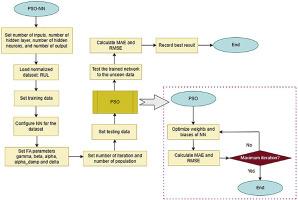基于粒子群优化-神经网络的电池剩余使用寿命估算
引用次数: 0
摘要
确定电池的剩余使用寿命(RUL)对于多个目的而言都至关重要,包括主动维护计划、优化资源分配、预防意外故障、提高安全性、延长电池寿命以及实现精确的成本节约。为此,本研究提出了粒子群优化-神经网络(PSONN)混合方法来估算电池的有效使用时间。在评估所提出方法的有效性时,使用了平均绝对误差(MAE)和均方根误差(RMSE)指标。本次研究采用的数据集包括八个输入参数和一个输出变量,代表电池 RUL。在进行分析时,将 PSONN 模型的性能与带有文化算法(CA-NN)和和谐搜索算法(HSA-NN)的混合 NN 以及独立的自回归综合移动平均法(ARIMA)进行了比较。研究结果表明,PSONN 模型的 MAE 为 2.7708,RMSE 为 4.3468,明显低于 HSA-NN(MAE:22.0583,RMSE:34.5154)、CA-NN(MAE:9.1189,RMSE:22.4646)和 ARIMA(MAE:494.6275,RMSE:584.3098)。PSONN 的最大误差也最小,为 104.7381,而 HSA-NN 为 490.3125,CA-NN 为 827.0163,ARIMA 为 1,160.0000。此外,PSONN 与其他方法(HSA-NN、CA-NN 和 ARIMA)的双尾概率值(P(T ≤ t))均低于 0.05 的显著性水平,这表明 PSONN 与其他方法(HSA-NN、CA-NN 和 ARIMA)之间的差异具有显著的统计学意义。这些结果凸显了 PSONN 模型在预测电池 RUL 方面卓越的准确性和稳健性。与其他方法相比,PSONN 的性能更优越,这表明 PSONN 是准确估算电池 RUL 的高效工具,从而为该领域的研究做出了贡献。本文章由计算机程序翻译,如有差异,请以英文原文为准。

Battery remaining useful life estimation based on particle swarm optimization-neural network
Determining the Remaining Useful Life (RUL) of a battery is essential for several purposes, including proactive maintenance planning, optimizing resource allocation, preventing unforeseen failures, improving safety, extending battery lifespan, and achieving accurate cost savings. Concerning that matter, this study proposed hybrid Particle Swarm Optimization–Neural Network (PSO![]() NN) for estimating battery RUL. In the evaluation of the proposed method, the effectiveness is assessed using the metrics of Mean Absolute Error (MAE) and Root Mean Squared Error (RMSE). The dataset employed for this investigation comprises eight input parameters and one output variable, representing the battery RUL. In conducting an analysis, the performance of the PSO
NN) for estimating battery RUL. In the evaluation of the proposed method, the effectiveness is assessed using the metrics of Mean Absolute Error (MAE) and Root Mean Squared Error (RMSE). The dataset employed for this investigation comprises eight input parameters and one output variable, representing the battery RUL. In conducting an analysis, the performance of the PSO![]() NN model is compared with hybrid NN with Cultural Algorithm (CA-NN) and Harmony Search Algorithm (HSA-NN), as well as the standalone Autoregressive Integrated Moving Average (ARIMA). Upon examination of the findings, it becomes evident that the PSO
NN model is compared with hybrid NN with Cultural Algorithm (CA-NN) and Harmony Search Algorithm (HSA-NN), as well as the standalone Autoregressive Integrated Moving Average (ARIMA). Upon examination of the findings, it becomes evident that the PSO![]() NN model outperforms the alternatives with an MAE of 2.7708 and an RMSE of 4.3468, significantly lower than HSA-NN (MAE: 22.0583, RMSE: 34.5154), CA-NN (MAE: 9.1189, RMSE: 22.4646), and ARIMA (MAE: 494.6275, RMSE: 584.3098). The PSO
NN model outperforms the alternatives with an MAE of 2.7708 and an RMSE of 4.3468, significantly lower than HSA-NN (MAE: 22.0583, RMSE: 34.5154), CA-NN (MAE: 9.1189, RMSE: 22.4646), and ARIMA (MAE: 494.6275, RMSE: 584.3098). The PSO![]() NN also achieves the lowest maximum error of 104.7381 compared to 490.3125 for HSA-NN, 827.0163 for CA-NN, and 1,160.0000 for ARIMA. Additionally, the low two-tail probability values (P(T ≤ t)), all below the significance level of 0.05, indicate that the differences between PSO
NN also achieves the lowest maximum error of 104.7381 compared to 490.3125 for HSA-NN, 827.0163 for CA-NN, and 1,160.0000 for ARIMA. Additionally, the low two-tail probability values (P(T ≤ t)), all below the significance level of 0.05, indicate that the differences between PSO![]() NN and the other methods (HSA-NN, CA-NN, and ARIMA) are statistically significant. These results highlight the superior accuracy and robustness of the PSO
NN and the other methods (HSA-NN, CA-NN, and ARIMA) are statistically significant. These results highlight the superior accuracy and robustness of the PSO![]() NN model in predicting battery RUL. This study contributes to the field by presenting the PSO
NN model in predicting battery RUL. This study contributes to the field by presenting the PSO![]() NN as a highly effective tool for accurate battery RUL estimation, as evidenced by its superior performance over alternative methods.
NN as a highly effective tool for accurate battery RUL estimation, as evidenced by its superior performance over alternative methods.
求助全文
通过发布文献求助,成功后即可免费获取论文全文。
去求助

 求助内容:
求助内容: 应助结果提醒方式:
应助结果提醒方式:


